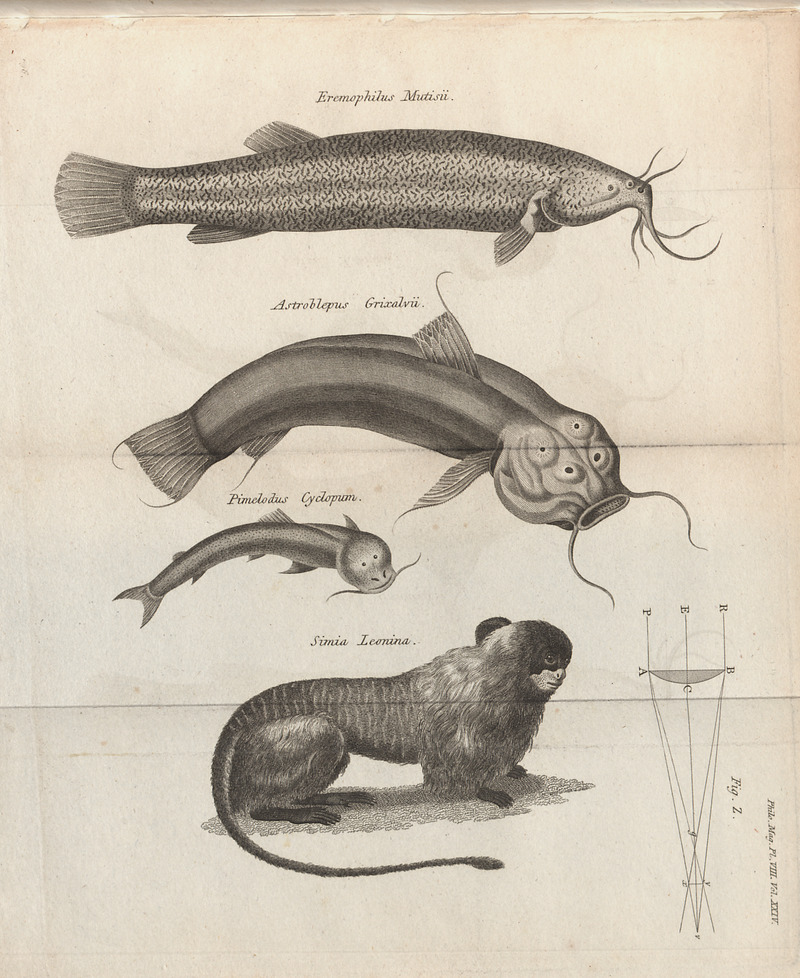Digitale Ausgabe
Download
| TEI-XML (Ansicht) | |
| Text (Ansicht) | |
| Text normalisiert (Ansicht) |
Ansicht
| Textgröße | |
| Originalzeilenfall ein/aus | |
| Zeichen original/normiert | |
Abbildungen

Zitierempfehlung
Alexander von Humboldt: „Memoir on the Eremophilus and Astroblepus, two new Genera of the Order of Apodes“, in: ders., Sämtliche Schriften digital, herausgegeben von Oliver Lubrich und Thomas Nehrlich, Universität Bern 2021. URL: <https://humboldt.unibe.ch/text/1806-Memoir_on_the-1> [abgerufen am 25.04.2024].
URL und Versionierung
|
Permalink: https://humboldt.unibe.ch/text/1806-Memoir_on_the-1 |
| Die Versionsgeschichte zu diesem Text finden Sie auf github. |
| Titel | Memoir on the Eremophilus and Astroblepus, two new Genera of the Order of Apodes | ||||
|---|---|---|---|---|---|
| Jahr | 1806 | ||||
| Ort | London | ||||
|
Nachweis in: The Philosophical Magazine 24:96 (Februar–Mai 1806), S. 329–332, Tafel.
|
|||||
|
Entsprechungen in Buchwerken als „Mémoire sur l’eremophilus et l’astroblepus, deux nouveaux genres de l’ordre des apodes“, in: Alexander von Humboldt, Recueil d’observations de zoologie et d’anatomie comparée, faites dans l’Océan Atlantique, dans l’intérieur du Nouveau Continent et dans la Mer du Sud pendant les années 1799, 1800, 1801, 1802 et 1803, 2 Bände, Paris: F. Schoell / G. el Dufour 1811 [1812], J. Smith / Gide [1813–] 1833, Band 1, S. 17–20.
|
|||||
| Sprache | Englisch | ||||
| Typografischer Befund | Antiqua; Auszeichnung: Kursivierung, Kapitälchen; Fußnoten mit Asterisken und Kreuzen; Schmuck: Initialen. | ||||
|
Identifikation |
|||||
Statistiken
|
|||||
Memoir on the Eremophilus and Astroblepus, two newGenera of the Order of Apodes. By M. De Humboldt *.
* From Recueil d’Observations de Zoologie et d’Anatomie comparé, 1re livraison.Communicated by a correspondent.† The French toise is about six feet four inches nine-tenths English.|330| an elevation, and in waters which are inhabited by almostno other living being. The naturalists, who fear that newspecies of the same genus may be discovered in very differentsituations, may change the name of eremophilus into that of thrichomycterus, taken from the barbillons or whiskers at-tached to the nose of this fish.
EREMOPHILUS. (See Plate VIII.) Apod. Character Genericus Essentialis.
- Corpus elongatum. Cirri maxillares 4, nasales semitubu-losi 2. Pinna dorsalis et analis. Membrana branchio-stega radiis 1—2.
- Corpore elongato, plumbeo, cærulescenti, maculis dædaleisolivaceis variegato; operculi branchiostegi; duplicaturaspinuloso-serrata.
ASTROBLEPUS. (See Plate VIII.) Apod. Character Genericus Essentialis.
* Mutisii and Grixalvii are doubtless very scientific names. Linnæus, togratify his puerile vanity, introduced the custom of giving arbitrary unmean-ing names of men to plants: Werner embraced the same unphilosophicalsystem of pitiable ambition in baptizing minerals (some wits have asserted,indeed, that such is his attachment to water, that he actually performed theceremony of sprinkling certain stones, giving them at the same time the fa-vourite name of some of his followers): and M. Humboldt now transfersmen’s names to the very opposite abodes of fire and water, in his volcanicfish! All the labours of these men have done much less to disseminate a tastefor the natural sciences, than the introduction of such an absurd practice haseffected in obstructing the advancement of real knowledge and true philoso-phy. Posterity, so far from venerating such names, will execrate the being,who, to conceal his real ignorance by the assumption of universal knowledge,could thus deliberately bury true science and much accurate knowledge underthe ruins of a Babylonish jargon! Peace to the manes of Lavoisier: althoughhe himself made no real discoveries, yet the philosophical use which he madeof those of the English and other philosophers will not speedily be forgottenby succeeding generations.—Translator.